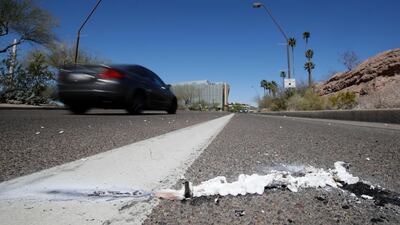Elaine Herzberg stepped out on to a road on Sunday night in Tempe, Arizona, pushing her bicycle – and became the first pedestrian to be killed by an autonomous vehicle.
The Volvo XC90 that hit her is one of Uber’s experimental self-driving cars and Tempe’s chief of police, Sylvia Moir, has since gone on record to say that it is highly unlikely the ride-hailing company will be held liable.
Herzberg, after preliminary examination of footage shot on board the car, appears to have walked out into the street from a central reservation, a short distance from a well-illuminated pedestrian crossing.
Even if the car had been piloted by an alert driver, there is little that could have been done to prevent the crash, Ms Moir told the San Francisco Chronicle.
Nevertheless, Uber has – not for the first time on the grounds of safety concerns – suspended its self-driving car tests in all US cities.
The fatality has understandably cast a critical light on this new and fast-developing technology. What is being hailed by car makers, as well as safety and environment campaigners, as the next true revolution in motoring might not be so great for us after all.
But it is worth pointing out that the car involved in Herzberg’s death did have a driver in the front seat. He claims that he only knew of her presence at the moment of impact, which happened at 61kph.

Uber has been testing and developing driverless car technology for the past two years in several US states, and it is not the only company to do so.
Google, Apple, Waymo and traditional car makers including Volvo, Mercedes-Benz, GM and Audi have been involved in a seemingly frantic race to be the first to introduce truly autonomous transport, with pedestrian and occupant safety, as well as environmental concerns being at the top of their corporate social responsibility agendas.
And states such as Arizona, keen to cash in on this potentially lucrative business, have been rather relaxed with legislation.
_______________
Read more:
Special report: How the internal combustion engine is running out of road
We test Super Cruise, Cadillac’s new hands-free semi-autonomous tech
Driverless cars: what are the biggest obstacles?
_______________
In Arizona these companies are permitted to operate their vehicles on public roads without a driver on board. Doug Ducey, the state’s Governor, said that offering them a “business-friendly and low regulatory environment” had been beneficial to the local economy.
California was to follow suit in just a few weeks but officials are now considering their options. More people are beginning to claim that the technology simply is not sufficiently advanced for it to be used in public.
'Remarkable to experience the future, but I knew I was still responsible'
The benefits of autonomous cars are obvious. Imagine a commute between Abu Dhabi and Dubai where all vehicles travelled at a constant speed, with safe distances between one another, accelerating and braking only when appropriate and changing lanes only when it was safe to do so.
Imagine, too, the positive effect on our air quality by the lack of carbon-dioxide emissions because the cars are battery-powered, and the ability for occupants to sit back, relax and not be stressed by road rage, tailgaters or other distractions.
The dream is nothing short of utopian motoring for everyone.
We have driverless technology available in cars on sale in the UAE. I have driven a Tesla Model S along the E11 in Dubai, having engaged its Autopilot mode.
In fairly light traffic, I set the car’s speed and left it to its own devices as it steered itself using the lane markers for guidance, accelerated and braked according to the behaviour of other road users and steered out of the way of a driver who decided to suddenly cut in front.
It was remarkable to experience the future but, at the same time, I knew I was still responsible for anything that happened.
The other self-driving vehicle death
Tesla rightly says Autopilot is a driver-assistance feature, not a substitute for a human operator – something that was brought to the fore in May 2016, when Joshua Brown was killed in his Model S while using the self-driving function in Florida.

The car’s sensors had failed to distinguish the white side of a turning lorry from the bright, sunlit sky, and the Tesla’s brakes weren’t automatically activated.
The lorry driver claimed that Brown had been watching a film when the collision happened and Tesla proved that he had ignored repeated warnings to put his hands back on the wheel.
Proponents of the technology say we should keep incidents such as these in perspective. According to the US Department of Transport, 37,461 people were killed on American roads in 2016 – a rise of 5.6 per cent on 2015.
Distractions, such as mobile phone use, accounted for 3,450 of those deaths, while 10,428 Americans might still be alive had they worn seat belts. As for pedestrians, 5,987 were killed during those 12 months.
Obviously, any move towards improving these statistics is a good thing but what we must never do, as drivers, passengers or pedestrians, is pass the buck on to computer-controlled machinery.
None of them is, or ever will be, totally infallible and our increasing reliance on technology is eroding our skills as drivers. How many of us would know how to react in a high-speed blow-out, or be able to correct a car’s steering if it lost control?
Driving is a privilege, not a human right, and as such we should all shoulder the responsibility when we’re in charge of a potentially death-dealing projectile.
The time when driverless cars are common will come, there’s no point denying that. Perhaps, though, the race to be first needs to slow down a bit.

